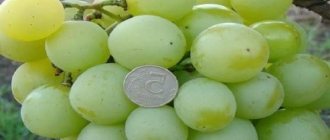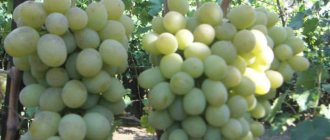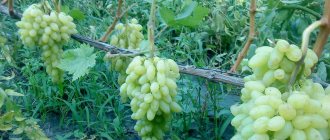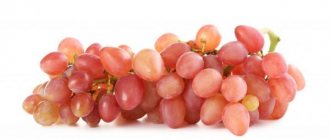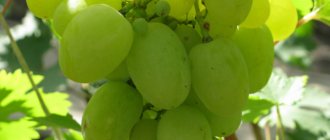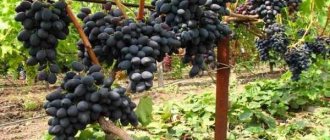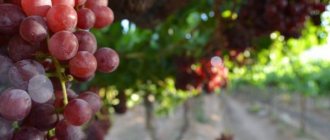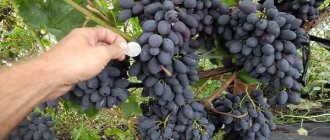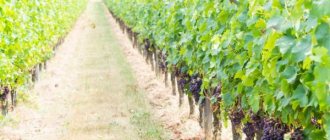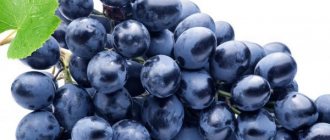Why do you love these grapes so much?
- The bunches of “Keshi” ripen earlier than other varieties.
- The harvest is consistently bountiful.
- Young shoots are ready to bear up to 2-3 full bunches per season.
- Excellent propagation by cuttings and grafting.
- The seedlings are able to bear fruit early.
- Not afraid of transportation.
- Tolerates low winter temperatures (down to -23°C) painlessly.
- Resistant to typical grape diseases: mildew, oidium, gray rot.
All these qualities, in addition to the original aroma and taste, make Kesha meet the requirements of an elite variety.
Information : The variety has exclusively table use and is consumed only fresh. Its berries are not used to make preparations; they are not usually processed. As a last resort, fresh Keshi berries are used for canapés or fruit salads and for decorating side dishes.
Table varieties also include Karmakod, Alexander and Lily of the Valley.
Diseases and pests
The described variety is characterized by fairly high resistance to diseases and pests, but the possibility of infection cannot be completely excluded. Regularly inspect the vine and grape leaves for signs of powdery mildew, gray rot and mites, which are the most common enemies of the Kesha variety.
Powdery mildew affects the green part of the grapes and spreads very quickly throughout the entire bush. The main sign of a problem is a slightly yellowish, even lumpy coating on the leaves, sometimes presented in the form of shapeless spots. To combat it, a solution of iron sulfate (300 g per 1 bucket of water) is usually used, as well as special fungicidal preparations: for example, “Strobi” and “Mikal”, diluted in water according to the instructions on the package. It is advisable to carry out processing of grapes in calm weather, having previously protected the skin and respiratory tract from contact with the chemical.
Gray mold is a fungal disease that actively develops at high humidity levels. The main symptom of grape damage is the presence of brown-gray spots on all parts of the bush; over time, damaged leaves and shoots fall off. The dead parts must be removed from the area, otherwise the fungal spores will return to the plant. To prevent the development of gray rot, the plant is sprayed with a solution of the drug “Folpan”, and for the active stage of the disease, the fungicides “Topsin M” and “Rorval Flo” are suitable.
We recommend that you find out why grapes dry out and how to deal with it.
The presence
of mites is easy to notice when examining the plant; you just have to look at the inside of the leaf. Main signs of pest activity:
- brown spots covered with slight pubescence (felt mite);
- light spots covered with a yellow coating (spider mites);
- yellow spots with a hole in the middle (leaf mite).
At the initial stage of the attack, you can remove the pest manually by wiping the leaf plate with a soap solution, but if the problem has become widespread, then you can no longer do without the use of insecticidal preparations.
The compositions "Aktara" and "Vermitek" will be effective in this regard, but when working with them it is important to be extremely careful, since they are very toxic. A more gentle means of combating ticks would be “Karbofos”, in addition to which you can use decoctions and infusions of wormwood, potato tops and tobacco. Find out why grapes on the bush wither.
To prevent diseases and pests, it is advisable to treat the plant with a 1% Bordeaux mixture twice a season, and also monitor the drainage of excess liquid from the bush.
Thus, the Kesha variety is not particularly demanding in terms of care, and with moderate attention it will always delight you with large and tasty bunches of grapes. Propagation of these grapes will not be difficult.
Its characteristics as a table variety
The main features of table grape varieties, which include the described sample, are:
- exquisite taste;
- thin peel;
- berry size;
- presentation of the brush;
- complex associative aroma;
- completeness of the chemical composition of the juice.
Based on the color of the fruit, table varieties are divided into four groups, but “Kesha” is represented only by white and red grapes, based on the heredity of the parents.
Help : Table grape varieties are not so easy to grow: they require serious care, additional feeding of the bushes, and strategic pruning.
The white variety also includes varieties such as Lancelot, Bianka and Husaine White.
Productivity and ripening time
The plant shows its first signal fruiting in the 2nd year after planting, commercial fruiting begins in the 4th - on average about 25-30 kg per bush. In industrial plantings, the Kesha grape variety is capable of producing high yields of 12-15 t/ha.
Removable maturity occurs 125-130 days after bud break . Due to high resistance to gray rot, grapes ripened in the third ten days of August can hang on the bushes until November. The taste qualities only improve. When the bunches remain on the bushes for a long time, the berries become covered with brown spots, while the taste is not reduced, but the presentation deteriorates.
The harvest can hang on the bushes without loss of quality almost until the first frost
Properly harvested fruits keep well in the refrigerator for almost four months. The juicy pulp is protected from damage by a dense skin, which is extremely rarely damaged during transportation, so the variety is considered suitable not only for amateur viticulture, but also for industrial cultivation for commercial purposes.
The opinion of an experienced Ukrainian gardener about the taste characteristics of berries on the bushes from late August to early November can be found in the following video:
What did noble parents give you?
And they are noble because in their homeland, in Moldova, the “Frumoasa Albe” variety is extremely popular under the name “White Beauty” and is ranked on a par with the “Queen of Vineyards” variety. The name of the other parent reflected all the strength of feelings experienced by the team of breeders of the All-Russian Research Institute named after. Potapenko, when they got him in artificial conditions - “Delight”.
The new variety was borrowed from Frumoas Albe:
- extraordinary sweetness of the fruit;
- harmony of taste and aroma;
- ability for strong growth;
- perfect pollination;
- high productivity;
- resistance to diseases (even phylloxera!);
- frost resistance is higher than general - up to -25 ° C;
- long-term preservation of the brush on the bush after ripening without loss of taste.
Arched, Isabella and Pink Flamingo can also boast frost resistance.
Inherited from “Delight”:
- the power of the trunks, which perform well as a rootstock;
- size and weight of the hand (up to 1.5 kg);
- high sugar content (up to 26%) and acidity (up to 9 g/l);
- suitability for storage without loss of taste for a month;
- increased resistance to frost;
- resistance to typical grape diseases.
Among the resistant varieties, it is also worth paying attention to Elegant, Citron Magaracha and Angelica.
Help : The most difficult thing in the process of breeding new grape varieties is to instill in them the quality of increased winter hardiness. After all, this culture historically developed in a warm climate. The inheritance of qualities is formed into a persistent trait if both parents possess it.
Advantages and disadvantages of the variety
Grape growers fell in love with the Kesha varieties. It is not for nothing that they are classified as elite grape varieties. The presented plant is a table variety, so in most cases it is used for consumption in its pure form. A table served with this delicacy looks very beautiful. Kesha is also used for the production of white wine, because, thanks to its muscat flavor, it is also excellent for these purposes.
Benefits of Kesha grapes:
- the grapes of these varieties ripen quickly, because all of them belong to early or mid-early grape varieties;
- the berries of this grape are highly transportable and unpretentious in storage;
- grapes of this variety are distinguished by a large number of fruitful shoots;
- these grapes are resistant to mildew and other fungal diseases;
- Kesha begins to bear fruit early and is characterized by a great acceleration in the growth of cuttings;
- Kesha variety berries have a harmonious and rich taste, which is why they are loved by ordinary people.
The disadvantage of this grape brand is the possible shrinkage of the berries when growing a large number of grape clusters.
Place of Birth
Like most new hybrids, FV-6-5 appeared in the VNIIViV special nursery in Kuban, or more precisely in Novocherkassk . Since the middle of the last century, this breeding center has prepared 75 varieties for testing, of which 50 are interspecific hybrids.
The main goal of the team is the promotion of varietal grapes to the harsh regions of the European part of the country and Siberia . Amateur winegrowers actively help them in this on their plots, bringing the new characteristics of the variety to the result of sustainable inheritance.
Hybridization of the variety is carried out:
- in the process of pollination of a bush with a more productive variety;
- in grafting a promising “newcomer” onto a proven rootstock (vegetative);
- in the selection of the results of cloning the best specimens;
- artificially.
Thus, over the course of many generations, the “Kesha” variety was given more and more new qualitative and agricultural characteristics, which was reflected in the synonymous series of its names.
Important : The “Kesha” variety is an interspecific hybrid, which was achieved as a result of targeted crossing of the best grape varieties only after 4 generations.
Origin story
This hybrid variety was bred in the early 90s of the last century by breeders of the All-Russian Research Institute of Viticulture and Winemaking named after. Ya. I. Potapenko" by crossing popular white table varieties: the Moldovan "Frumoasa Albe" and "Vostorga" (their own selection).
“Frumoasa Albe” (pictured left) and “Delight” (right) are grape varieties that served as parent forms
Winter hardiness and the wonderful taste of the fruit have made this hybrid in demand not only in private gardens, but also in industrial plantings in many regions of our country, as well as in Ukraine and Moldova. However, without proper testing, recognition of new forms as varieties and inclusion in the State Register of Breeding Achievements, their path to commercial vineyards is still closed.
Currently, the possibilities of growing this variety of crop are being assessed on experimental plots in the soil and climatic conditions of the southern and central regions of Belarus and the Piedmont region of Crimea.
You can learn more about the features of “Keshi” from the video filmed by a Russian amateur winegrower:
Modifications: “Kesha 1″(Talisman), “Kesha 2”, “Kesha Red”
The grape variety described is characterized as:
- vigorous, with large bright leaves that stand out until the fruits ripen;
- having a powerful root system;
- self-pollinating;
- early ripening (up to 130 days);
- with shoot fertility up to 90%;
- consistently high-yielding, with increased load of mature bushes;
- successful for propagation by cuttings with subsequent fruiting after 3-4 years;
- having high transportability;
- able to resist fungal infections;
- frost-resistant (down to -23°C).
During the fruiting period, cone-shaped or indefinitely shaped brushes are formed, differing in:
- medium density;
- long comb;
- weighing up to 1.5 kg;
- load - 1-2 brushes per escape;
- long-hanging, without loss of taste.
Interesting : During planned crop rationing, clusters are left on the vine according to the number of years the plant has lived.
As a table variety, “Kesha” characterizes the quality of berries, which:
- have a predominantly sweet taste, which is determined by sugar accumulation up to 24% , and acidity of only 5 g/l ;
- have a dense consistency;
- have a dense but easily bitten skin;
- combine nutmeg or nutmeg-pineapple aroma;
- keep the tasting score at 8;
- quite large (up to 15 g) with 2-3 seeds;
- have an oval shape;
- light green in color or milky white, cream;
- ripe berries do not burst and can be stored in a brush for up to 1 month.
We are trying to understand the large family.
“Kesha” is the starting variety , on the fertile basis of which its other modifications were obtained:
- “Kesha 1” ( “Super Kesha” or “Talisman” ) is a hybrid characterized by increased resistance to diseases and low temperatures (when covered - up to -25°C); its berries are even larger, and the ripening time is later; prone to overload; seedlings after planting in the ground are ready for fruiting in the second year.
- “Kesha 2” (“Kesha nutmeg”, “Zlatogor”, “Tamerlan”, “Kesha Radiant”) - a hybrid resulting from crossing Kishmish radiata with “Kesha1” (selection by V.N. Krainov);
Large berries, when ripe, acquire an amber color and a pronounced nutmeg aroma; conical brush with a “wing”; ripening time reduced to 115 days; when covered, frost resistance is down to -26°C. - "Kesha Red" - a folk hybrid resulting from crossing Keshi1 and the Cardinal variety (table grapes from southern Europe); a very vigorous plant with an average ripening period;
The clusters are round or conical of medium density; The weight of the brush with good care reaches 2 kg; large round berries of all shades of cherry color are covered with a light waxy coating (pruin); berry structure according to the Cardinal type; the harmonious taste of the fruit is accompanied by an apple tone; in the main characteristics it repeats Kesha 1:- high-yielding;
transportable;
- resistant to fungal diseases;
- has high fruitfulness of shoots;
- long-hanging, without loss of taste;
- frost resistance - up to -26°C.
Photo of the Kesha Talisman grapes:
Bogatyanovsky, Druzhba and Veles also have a nutmeg aroma.
Photo of “Kesha Tamerlan” grapes:
Photo of “Kesha Red” grapes:
Help : It is worth remembering that the result of introducing a variety will always depend on climatic conditions and agrotechnical measures, and will never be the same. It is no coincidence that on forums amateurs identify rooted varieties from photographs.
More photos of Kesha grapes:
Description of the variety
Kesha's bush is vigorous; during the growing season it can grow to a height of 5–6 meters, with good ripening of the vine. There are flowers of both female and male types (with the exception of Keshi 1 - he has only female flowers). The clusters come in various structures - from conical to cylindrical-conical; less often they have an indeterminate shape. The weight of the bunch is about 600–1000 g.
A bunch of Kesha table grapes weighs 600–1000 g, and one berry weighs 12 g
The taste characteristics are rated very highly by connoisseurs, as are the fruiting criteria. The tasting rating of the variety is 8 points, which is quite a lot for table grapes. The fruits of the Kesha grape have the following characteristics:
- the size is large, the color is light amber, the average weight of one berry is 10–12 g, its shape is often round or oval;
- thanks to the dense peel of the fruit, these grapes can be easily transported over long distances, maintaining their commercial characteristics;
- in the fleshy and juicy pulp there are few seeds - about 2 or 3;
- the concentration of sugars in the pulp is high, corresponding to 18–25% (Keshi berries got their sweetness thanks to the parent variety Delight), but the acidity is average and equal to 6–8 g/l.
Video: appearance of Kesha grapes with ripe bunches
How to root correctly in your garden?
- First you need to choose the right place for the southern guest. The best choice would be the sunny side of the wall of a house or other buildings that will protect the plant from the winds.
Deep groundwater and fertile soil are desirable. In order not to destroy the structure, you need to create a reliable support for the vine 40 cm from the wall.It is optimal to plan the planting of seedlings in the spring, when the ground has already warmed up to 10°C and the air temperature has become consistently positive ( 15°C ).
The pit is prepared in advance, in the fall, replenishing it with humus and fertile soil.
An indicator of correct planting will be the position of the root collar, which should always remain above the soil surface. To strengthen the seedling, tie it to a support, then water it abundantly (up to 30 liters per trunk).
A vine planted before winter must be insulated, creating a structure from a hollow container and soil so as not to damage the shoot.
- Grafting with cuttings allows you to get a harvest faster, but requires special care in preparing and carrying out the operation:
- the cuttings and rootstock are prepared in advance; the first is cut with a wedge and kept in a solution of the “Gumate” preparation;
- the old bush is trimmed, carefully cleaning the cut surface;
- carefully split the trunk with a hatchet, trying not to damage the plant;
- the “Keshi” stalk is inserted into the split and pulled together with twine over the fabric;
- create support for the rootstock.
Important : Grafting works better if the rootstock has a large supply of perennial wood. The soil should contain 15 mg/100 g of phosphorus and potassium.
What are the advantages?
Grapes have many benefits, including the following:
- high productivity;
- relatively low care requirements;
- regular appearance of fruits;
- uniform ripening of berries;
- rapid acclimatization to a new growing region;
- pleasant taste;
- good presentation;
- long shelf life;
- good immunity to fungi.
The disadvantages of the variety include average resistance to diseases characteristic of most varieties of grapes. This hybrid does not tolerate frost well, provided that the vine is left uncovered for the winter. In addition, due to its rapid growth, the plant must be pruned in a timely manner. The remaining shoots and stepsons form a crown over the course of several months, which interferes with the ripening of the fruit.
Special care
And a large-fruited variety can disappoint with small sour berries if you violate a set of agrotechnical measures:
- watering - twice at the beginning of the season (before buds open and after flowering); in case of severe drought, additional moisture will be relevant;
- application of phosphorus-potassium and nitrogen fertilizers without exceeding the norm; to prevent berries from peas, boron is added to the soil as a microelement;
- forming a crown on a trellis with pruning before sap flow to regulate the number of shoots; Autumn pruning is also used to enhance reproduction;
- rationing of bunches to avoid overload (one bunch per shoot); in arid climates, half of the ovary can be left;
- prevention of diseases using a 1% solution of Bordeaux mixture (a mixture of solutions of freshly slaked lime and copper sulfate) - twice per season;
- During the ripening period of grapes, it is important to protect them from “freeloaders” from the world of birds and insects (wasps). To do this, wrap the brushes separately with mesh fabric (such as gauze) or, for large planting areas, stretch fine-mesh mesh over the entire trellis. Noise repellers are ineffective.
Features of cultivation
The “cache” variety is not too demanding to care for, but it is still important to choose the right place for planting it and comply with all agrotechnical requirements, such as proper watering, fertilizing and pruning of bushes.
“Kesha” on the gazebo
Boarding time
The optimal time for planting this grape variety in central Russia is spring (late April or early May), for the southern regions - spring and autumn. The main thing is that the air temperature is at least +15 °C, and the soil warms up to at least +10 °C.
The place should be protected from gusty winds and sufficiently lit, but it should be taken into account that direct sunlight hitting the leaves can leave burns on them. It is also necessary to monitor the groundwater level in the selected area - the bushes of this grape have long roots and constant contact with moisture not only negatively affects the quality of the crop, but also provokes root rot.
In the fall, it is necessary to begin preparing the soil by clearing it of plant residues, digging with shovels and applying the necessary fertilizers.
The variety prefers light, fertile soil with good moisture and air permeability. The best option is black soil.
Watering and fertilizing
Grape bushes of this variety do not need too much moisture. Under favorable weather conditions, they should be watered only 3 times per season: after removing the winter shelter, before flowering and during berry set. 15-20 liters of warm, settled water should be poured under each bush.
Reference! When watering, you need to focus on the condition of the top layer of soil: you need to moisten the soil as soon as it dries 5 cm deep.
Plants respond well to both organic (humus, rotted manure) and mineral (which contain potassium and phosphorus) fertilizers.
It is better to avoid nitrogen-containing fertilizers altogether or use them only when absolutely necessary. This is due to the fact that excessive amounts of nitrogen are detrimental to bushes.
Trimming
Sanitary pruning is carried out annually before buds appear on the vine and consists of removing all frozen or damaged branches from the bushes.
Also, due to the rapid growth of new shoots, it is necessary to regularly carry out pinching, leaving 1 leaf for each axillary bud. To avoid peas from berries, you should thin out the clusters in a timely manner.
Reference! The permissible load is 35-40 buds per bush and 1-2 bunches per shoot.
Diseases and pests
The variety is resistant to fungal diseases, but has no immunity to bacterial diseases and oidium. That is why it is necessary to carry out preventive treatment of bushes with Bordeaux mixture and fungicidal preparations at least 2-3 times during the entire growing season.
“Keshu” is practically not attacked by pests. Among insects, the most dangerous are mites, which can be gotten rid of with insecticides, such as, for example, Aktara, Vermitek or Karbofos.
Recommended preparations for diseases and pests of grapes
Frost resistance
The bushes can easily withstand air temperatures down to -23 °C. If the variety is grown in regions with harsher winters, the plants must be covered by removing the shoots from the support, securing them near the ground and covering them with spruce branches, moss or leaves.
Harvest storage
Thanks to the fairly dense skin, the berries of this variety not only tolerate transportation even over long distances without problems, but also have good shelf life. In the refrigerator or a cool, dark room, the harvest can be stored for about 3 months.
Cultivation regions
The variety can be successfully cultivated in all regions. The only difference is that in the southern regions the bushes can do without winter shelter, but in the northern regions it is required.
Use
When consuming fresh grapes, the following rules :
- You need to eat fruit between meals, at least an hour after eating;
- You can eat berries with their seeds;
- Do not combine it with carbonated drinks, chocolate, kefir or milk;
- the daily intake of grapes with a healthy diet is no more than 0.5 kg;
- It is better for late pregnant women to avoid this fruit.
Given the generally accepted calorie content of grapes, you can use them to lose weight using a special diet (eat only grapes for 3 days, eating up to 1.5 kg per day, and then replace dinner with healthy berries for 2 weeks).
There is also a system of grape therapy, but in each specific case it is worth consulting with a specialist, because the “berry of health” also has contraindications.
Princess Olga, Russian Concord and Ideal Delight also have healing properties.
Application and evaluation of the Kesha variety
Kesha grapes can be of several types (SuperKesha and Tamerlane). All these species have their own characteristics, but what they have in common is high winter hardiness and resistance to grape diseases: fungal infections and pests.
All of these varieties are table varieties and in most cases are used directly for consumption, but they also make good white wine. The variety of the second stage of selection (or Kesha Muscat, which says a lot) especially distinguished itself in winemaking. The muscat notes of this grape variety delight the taste buds of gourmets from all over the world. Tasters rated the taste characteristics of the presented grapes as eight points out of a maximum possible ten. This indicates that this variety is not without reason classified as elite.
Kesha grapes will give a large harvest if they have proper care.
